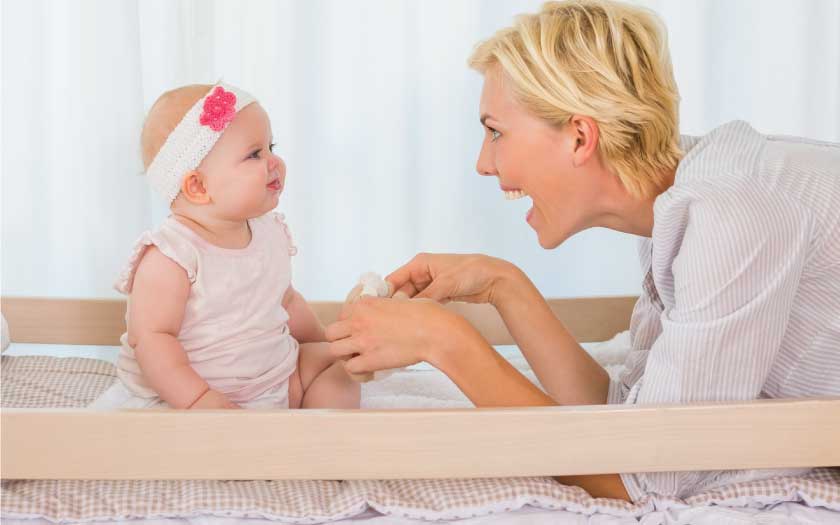Even as infants, babies thrive on attention or interaction and the quality of that interaction, coupled with the attention and care provided by caregivers can have an impact on their development.
Think of it — Doesn’t your baby seem to get excited at the sight of anyone lingering nearby, especially from two months onwards? Believe it or not, your baby may seem oblivious to everything that’s going on around him or her, but nothing can be more further than the truth for they are indeed becoming more and more aware of their surroundings with each passing day.
As babies enter the second month of life, they become noticeably more interested in everything that’s going on around them. At this stage, simple back-and-forth interactions — anything from singing a song to your baby to cooing and smiling back at him go a long way in the development of your precious little one.
They love gazing at faces too, especially at mom’s, and can recognize their mother’s voice. Infants tend to respond to their mother’s voice by looking alert and becoming less active. The little one may even turn that tiny head around in a bid to find the source of a new sound or to check if mom’s nearby. By constantly smiling and talking to her baby, a mom’s presence will become a familiar source of calmness and comfort, and the little one will learn to associate her with getting nourishment, warmth, and soothing touches.¹
Toys that appeal to the senses of sight, hearing, and touch:
- rattles
- textured toys
- musical toys
- unbreakable crib mirrors
Fun ways to interact with your baby include:
- Move an object slowly from side to side, and watch as your baby tracks its movement, which is one of the ways a baby builds his visual skills.
- Hang a mobile toy or rattle near enough for your baby to kick at. Over the next couple of weeks, the baby will begin to connect the act of kicking with the sounds the toy makes when struck. Other than helping the baby get acquainted with the concept of cause-and-effect, the baby might also discover that the ability to make some noise is just plain fun!
- Adding a massage for your baby after baths or before bedtime helps the baby feel bonded to you and also helps the little one understand that his body belongs to him (body awareness).
- Read to your baby or just let him gaze at the pictures. Soon enough, the little one will not be contented to just looking though, and will probably reach out to grab a page for a taste!
- Bring different objects close to your baby and let him touch, feel, look, and yes, even taste them, so that baby can make use of all his senses.
Know when the baby’s had enough
There is a limit for everything, and for babies especially, there is indeed such a thing as too much stimulation. When that happens, they will act out in several ways to indicate that they need a break.
Babies’ limits to stimulations vary from one another. Some can take in a lot of stimulation before they begin to get cranky and/or fussy, where else other babies may get overwhelmed very quickly by something as insignificant as the brightening the lights in the room, for instance.
Some common indications that a baby has had enough stimulation include:
- Turning his head away from you
- Avoiding eye contact
- Arching his back
- Crying and fussing
- Hiccuping
When you see these signals, it’s time to let baby get some rest, which can either mean a short snooze or simply snuggling in your arms.
You’ll know your baby is ready to play again when his expression is calm and clear-eyed, when he meets your gaze and moves his arms or legs turns toward you. Watching your baby while he plays will give you an idea of how the little one manages and responds to stimulation. Soon, you’ll be able to understand what and how much play your baby enjoys, how to recognize when he’s had enough, and how to soothe and comfort him when he gets cranky from over-stimulation.
In time, you’ll recognize when your baby is ready to play and when the baby would rather be left alone. Here are the two main indicators:
- A baby who is quiet and alert will be attentive and responsive and interested in his or her surroundings.
- A baby who is awake but active (squirming, flapping arms, or kicking legs) or fussing will be less able to focus on you. The baby may seem agitated or start to cry when you try to get his or her attention. These are signs that your baby may be getting overstimulated.
When to be concerned
Not all babies will develop in the same way. Some babies make eye contact and sounds early, while others might not until three months.
If your baby doesn’t seem to do what other babies are doing, it doesn’t necessarily mean that something is not right. You know your child better than anyone else. If you’re worried, talk to your doctor or any other child health professional. If your doctor doesn’t have concerns about your child, but you still do, it’s perfectly alright to seek a second opinion.
Reference:
1. http://kidshealth.org/en/parents/learnnewborn.html
Featured image source: Fotolia


